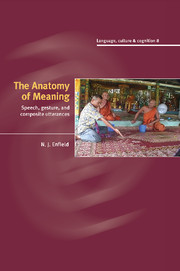8 - Conclusion
Published online by Cambridge University Press: 21 July 2009
Summary
In battle there are only the normal and extraordinary forces, but their combinations are limitless.
Sun TzuThe anatomy of meaning: summary remarks
In solving the ever-present puzzle of figuring out what others are trying to say, our evidence comes in chunks: composite utterances built from multiple signs of multiple types. These composites are produced by people on trajectories of collaborative social activity. As communicative behaviours, they are strategic, context-embedded efforts to make social goals recognizable. The essential claim of this book is that if we are to understand how people interpret such efforts, our primary unit of analysis must be the utterance or move, the single increment in a sequence of social interaction. Component signs will only make sense in terms of how they contribute to the function of the move as a whole.
This book has focused on moves built from speech-with-gesture as a sample domain for exploring the anatomy of meaning. But the analytic requirement to think in terms of composite utterances is not unique to speech-with-gesture. Because all utterances are composite in kind, our findings on speech-with-gesture should help us to understand meaning more generally. This is because research on the comprehension of speech-with-gesture is a sub-field of a more general pursuit: to learn how it is that interpreters understand token contributions to situated sequences of social interaction (cf. Schegloff 1968, Goffman 1981).
- Type
- Chapter
- Information
- The Anatomy of MeaningSpeech, Gesture, and Composite Utterances, pp. 221 - 228Publisher: Cambridge University PressPrint publication year: 2009

